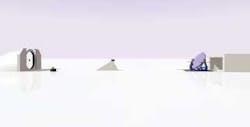World's best seeing site discovered
With funding for the Hubble telescope uncertain beyond 2007, the possibility of finding lower-cost Earth-based telescope alternatives is exciting to the astronomical community. Recent observations of winter-time seeing from Dome C, a high point on the Antarctic plateau, suggest remarkable clarity that would allow construction of an Earth-based telescope that could easily compete with telescopes in space.1
The primary criterion for selecting a ground-based telescope site is that celestial observations exhibit extremely low “jitter”-the wobble in the apparent position of a star caused by light bending as it passes through regions of different refractive index in the Earth’s atmosphere. The best midlatitude sites have a median jitter range of 0.5 to 1.0‑arcsec; incredibly, median seeing at Dome C is 0.27 arcsec, and below 0.15‑arcsec 25% of the time. A telescope at Dome C could compete with a telescope two or three times larger at the best midlatitude observatories, and could even compete with a space-based telescope like Hubble.
Will Saunders and Andrew McGrath of the Anglo-Australian Observatory (Epping, Australia) have designed a telescope that capitalizes on the unique Antarctic environment of Dome C: a 16-m, wide-field, fixed-axis, all-reflective, segmented f/4 Schmidt telescope (see figure).2 A 10- to 30-m-high rampart base would be needed for the corrector and the primary mirror of the telescope to avoid ground-level turbulence. The 16-m corrector mirror would consist of segmented plates, deformable at the ±100 µm level, with deformations being produced by 500 to 2000 piezoelectric actuators.
Also 16 m in diameter, the primary mirror would consist of 1- to 2-m fixed glass plates or segments and would produce 0.05-arcsec pixels at prime focus to match the best 0.1-arcsec viewing conditions at Dome C. An f/4 prime focus and f/13 or f/40 Cassegrain focus would produce a large field of view and easily allow natural guide-star adaptive-optics (AO) correction for widefield optical and near-IR spectroscopy over 3° fields with 0.25-arcsec resolution. In addition, the diffraction-limited optical imaging over arc-minute fields would yield six times better resolution than the Hubble space telescope, all at a maximum cost of U.S. $200 million dollars, compared with $500 million for a 30-m-class extremely large telescope and $2.2 billion for the Hubble.
Better than the South Pole
Scientists at the University of New South Wales (New South Wales, Australia) and at the Cerro-Tololo Inter American Observatory (La Serena, Chile) have long considered the Antarctic plateau for a major observatory. Fortunately, the poor seeing conditions found at the South Pole (caused by a turbulent air layer 200 to 300‑m from the ground) are absent at Dome C because of its higher elevation (3250 m) and lower wind speeds-although the best periods of superb seeing below 0.2 arcsec are during winter after sunset.
In January 2004, the scientists installed a multi-aperture scintillation sensor (MASS) to measure wintertime seeing. The MASS uses the spatial and temporal structure of single-star scintillation (intensity fluctuations) to evaluate vertical refractive-index fluctuation profiles from six layers within the atmosphere, at 0.5, 1.0, 2.0, 4.0, 8.0, and 16.0‑km. Simultaneously, a sonic detection-and-ranging (SODAR) instrument determined the contribution from the layer between 30 and 500 m. The mean Dome C seeing of 0.27 arcsec is observed at midlatitude sites such as Cerro Paranal and Mauna Kea much less than 1% of the time, and the best seeing of 0.07 arcsec at Dome C is the lowest value reported anywhere. Fewer actuators, by a factor of four to ten, would be required on a Dome C AO correction system to achieve the same residual wavefront error as a midlatitude system.
While approval to actually build a 16-m-diameter telescope may be years into the future, avenues of funding are currently being sought for development of a 2-m-diameter PILOT (Pathfinder for an International Large Optical Telescope). The PILOT would allow development of the technologies and techniques required to successfully exploit the full potential of the Dome C site. In fact, even a 2-m-diameter telescope at Dome C would be competitive in the IR with an 8-m-diameter telescope at a midlatitude site.
REFERENCES
1. J. S. Lawrence et al., Nature 431, 278 (Sept. 16, 2004).
2. W. Saunders and A. McGrath, SPIE conference, Glasgow, Scotland (June 2004).

